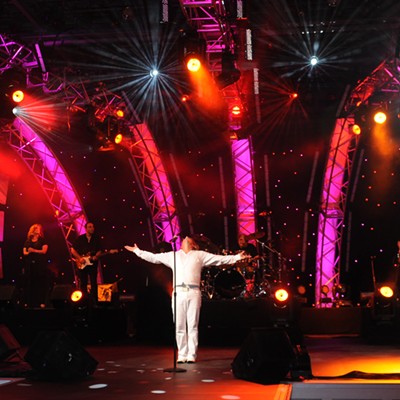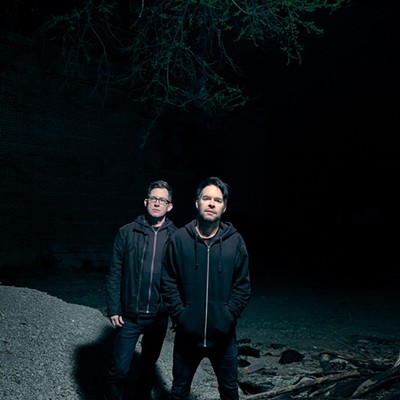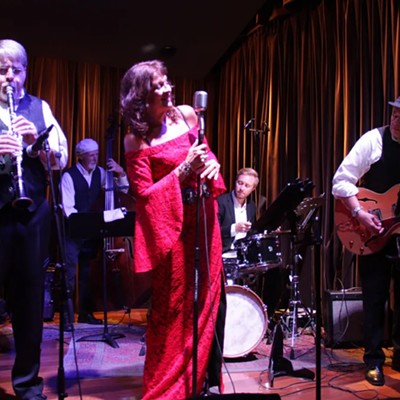We're just a bunch of music nerds."
That's how keyboardist Cassie Van Gelder and, by implication, her three partners in the up-and-coming Tucson rock-band Seashell Radio describe themselves while explaining the diverse range of music produced by their efforts.
While Van Gelder and cellist Esmé Schwall have classical and jazz backgrounds, drummer Fen Ikner and guitarist Courtney Robbins grew up playing in rock bands.
Drawing from progressive and classic rock, folk, alternative, jazz and classical, and incorporating the occasional sound effect or found sound, Seashell Radio plays music that, by default, might be called avant-garde. But it's also accessible to mainstream ears. The band's tunes may sound unusual on first listen, because together, these four musicians actually are forging a unique new sound of their own.
And because Seashell Radio's music is fresh, and not simply a rehashed version of something familiar, some listeners might call it "weird."
"We're not trying to be weird for the sake of being weird," said Robbins when the band gathered recently for an interview at Ikner's downtown-area home. "It's just sort of what comes out, and I don't feel like it's that weird, really. There's some weirdness to it in that it's not your usual stuff."
Said Ikner: "I'd much rather fail at trying to do something that I've never done before, or heard done before, than just do the same old thing."
Seashell Radio will celebrate the release of its debut full-length CD with a gig Friday night, Aug. 6, at Plush. The band will play about 10:30 p.m., in between sets by the Tucson band Young Mothers, and Kinch, from Phoenix.
Released and marketed independently by the band, What Do You Have Against Happiness? will be available at the gig. You can also buy the disc at www.seashellradio.com.
Following the CD-release gig, the band will take off for a short West Coast concert tour.
The current lineup of Seashell Radio is something of a second incarnation. Van Gelder noted that the personnel at the band's 2008 formation included her, Ikner and Schwall, as well as two other players who have since left the band. After those departures, Robbins joined the band in the fall of 2009.
All four members come from colder climates—upstate New York, Oregon, the Midwest, New England—and they are relative newcomers to Tucson. Robbins has been in the Old Pueblo the longest, at about six years. Robbins, who is happy to call herself a full-time musician, has recorded solo CDs with her own band; she also performs with Leila Lopez, among other acts.
Ikner, who has a day job working for a microphone company, also works as a recording engineer. He plays with other artists such as The Modeens, Michael P. Nordberg, and the Courtney Robbins Band.
As a classically trained cellist, Schwall has done her share of for-hire string-quartet jobs, and hopes never again to play Pachelbel's "Canon." She's also a master's candidate in creative writing at the UA.
With no bass guitar in Seashell Radio, Schwall can handle the low end or melodies on her cello, an increasingly popular instrument in rock bands. "It's got the perfect range to be versatile," she said, chuckling that "it's just that it can also be a feedback machine."
Like Schwall, Van Gelder is conservatory-trained. She grew up playing in church-oriented ensembles with her family, and, unlike the other Seashell members, she never really played in rock bands before this one. Nowadays, she works as the piano technician for the UA School of Music.
The four members not only bring a wide range of musical backgrounds to their collective table; all of them write songs and sing. They testify to the fact that the group operates in a manner as close to a true democracy as one might find in music these days.
The shared workload and shared artistic satisfaction is important to each of the Seashell players.
"That, to me, is my favorite thing about it," Ikner said. "I've always either been in bands where it's like you're in somebody else's band, or you're the one person doing anything. I've always wanted other people to pitch in, or to be able to pitch in without stepping on each other's toes."
When Seashell Radio plots its creative direction, "it just happens," Van Gelder said, her bandmates nodding in agreement.
"One of us will say, 'Hey, I have a song!' And we'll all go, 'Cool, play your song,'" said Ikner.
Said Schwall: "Someone hears a new harmony in the shower or whatever, and when we all hear it, we get excited. ... You know it's working when we get excited enough, and we don't want to stop practice."
Early tunes by Seashell Radio were written by band members apart from each other, many of them preceding the formation of the band. "Now we're getting even more productive and creative in how we go about making songs, because we are writing while we are all members of the band," Ikner said.
More and more of the band's new songs are getting close to being co-written by all four members, Van Gelder added.
"It helps that none of us is completely ego-driven, either," said Robbins. "We're willing to bring in just an idea or a half-finished song, and allow or trust the others to add to it."
Said Schwall: "I think that no matter who wrote them, we all really feel like these are 'band songs' now." She summed up the creative process as being "about our relationships with each other and not feeling the need to always have to get our own way."







